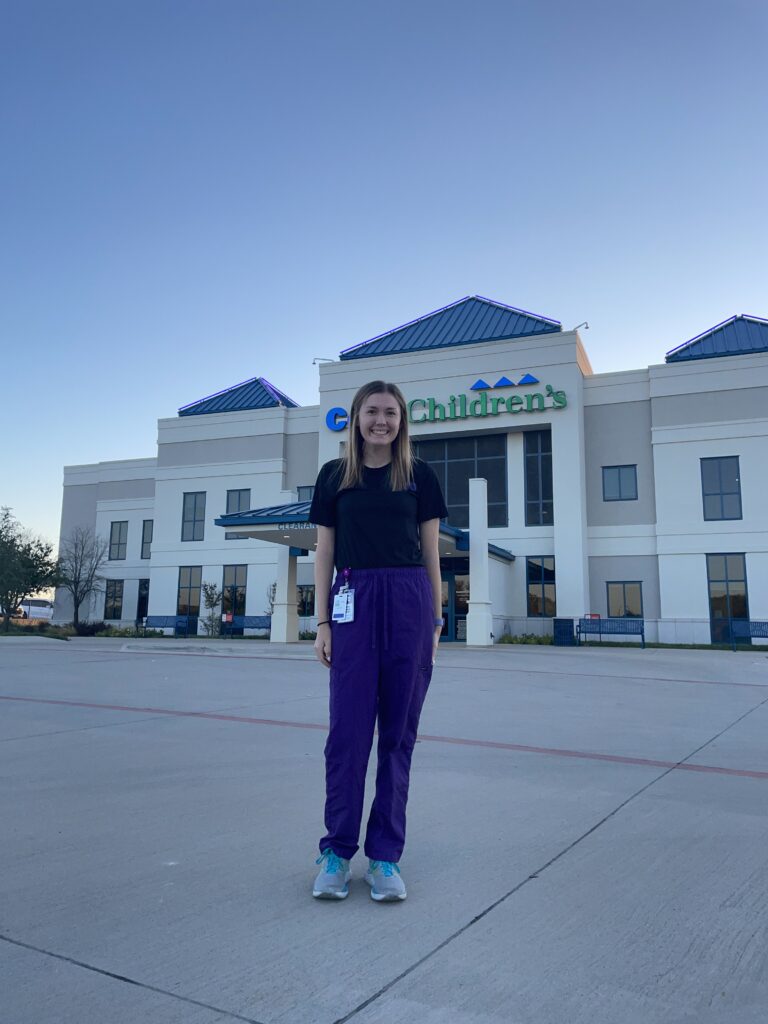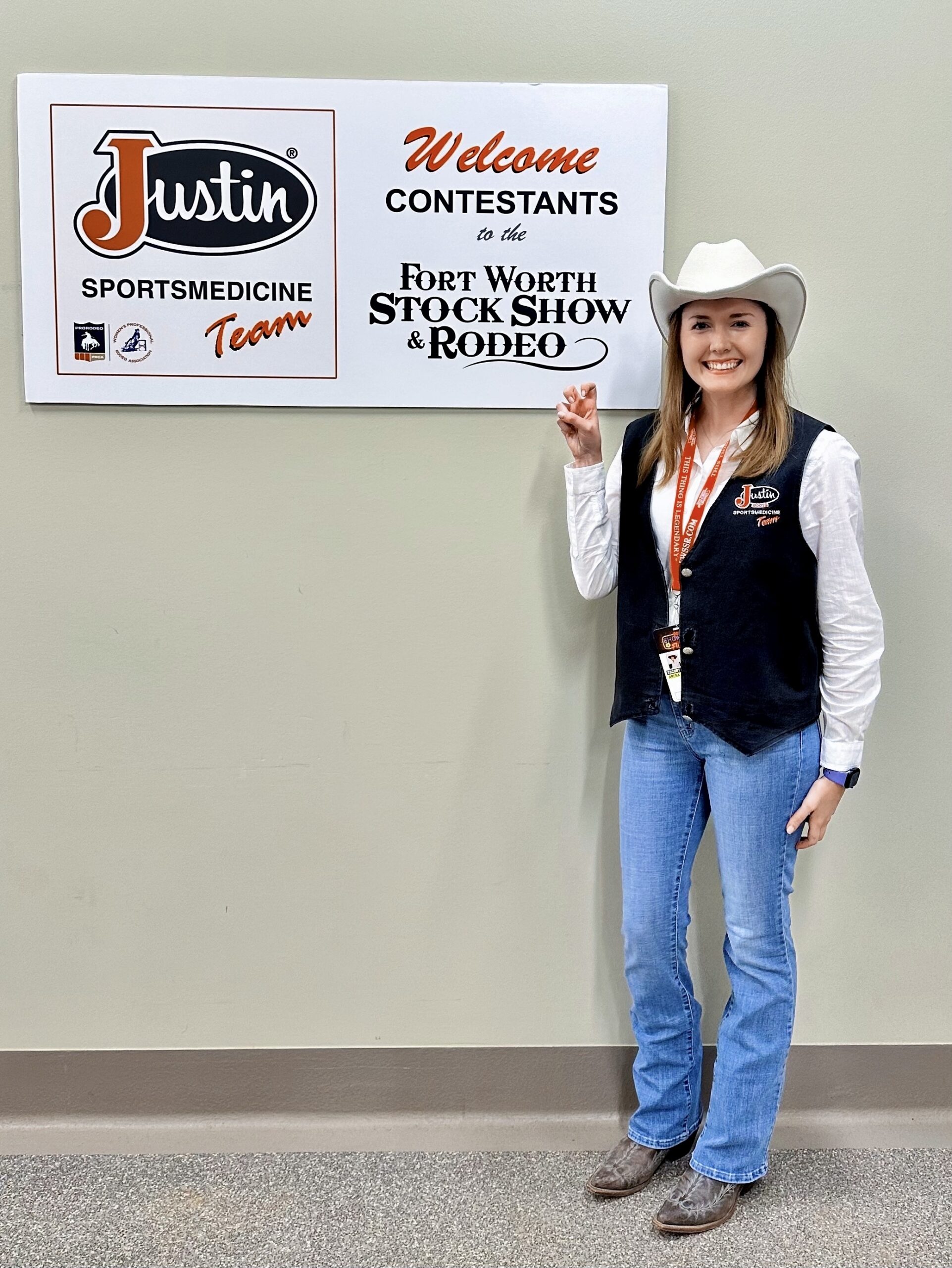By Katie Smith, a first-year TCU master’s in athletic training student.

You see us on the sidelines of the football field and on the bench of the basketball court. To some, we are the “water girls,” but we are so much more than that. We are student athletic trainers.
For many, college life consists of going to class, studying, participating in some extracurricular activities then waking up the next day and doing it all over again. However, for us, that usually isn’t the reality. Early mornings, a lot of hard work and living in the athletic training room; we have a unique experience that is different from every other student who walks through the doors at TCU.

Prepping for Clinical Rotations
In my first summer as an athletic training student, we hit the ground running. Courses like “Introduction to Musculoskeletal Evaluation,” “Therapeutic Interventions,” “Research in Athletic Training,” and “Clinical Skills and Emergency Management” teach us basic knowledge to get us ready for our first clinical rotations. These are beneficial to take in the beginning because not only is it a review of important material from our various undergraduate backgrounds, but they teach us new concepts that we’ll need to know for our first summer clinical experience. After taking some more summer courses, we immediately jump into our first clinical.
Before starting our clinical rotation, we go through a series of meetings with our clinical coordinator to figure out which sites will set us up for success in the setting we want to pursue.
From Football to Orthopedics
Prior to coming to TCU, I was set on a career with a professional football team, so my first clinical site was with TCU Football. I’d wake up at 4 a.m. then head to the football facility to set up the field for practice, have practice and clean up afterward. We followed that by providing post-practice treatments, restocking fridges and providing more treatments until it was time to go home. This day-in-the-life reality continued into the fall camp. Unfortunately, due to some health issues during the summer of my first year, my football experience was very short-lived.
This caused my clinical site to change to the Cook Children’s Orthopedics Sports Medicine clinic where I worked alongside a physician and athletic trainer on staff. This was such an amazing experience because not only did I learn a ton from the health care providers there, but it also opened my eyes to other athletic training settings that I didn’t know about or truly considered.
Endless Possibilities

Before taking my courses, I was not aware of all the needs that exist for athletic trainers and the various settings they work in. I was convinced it was just high school, college and professional sports. With growing opportunities in the military, physician private practices, warehouses for companies like Amazon, NASA and local police and fire departments, the options are endless!
As a part of our program, I even had the opportunity to gain experience observing the athletic trainers that work with the Fort Worth Stock Show and Rodeo. With the immense physicality of the sport and the number of injuries that can occur, I caught a glimpse into the day in the life of a rodeo athletic trainer. Nothing compares to providing treatments and emergency medical care for bull riders! This is part of what makes being in a city like Fort Worth unique – the clinical opportunities are limitless and there is no shortage of people and places to learn from.
The rest of the semester, I continued learning and getting hands-on experience at Cook Children’s while continuing classes. Attending classes while doing clinical allows us to quickly apply what we’re learning. By taking “The Upper Extremity” and “The Lower Extremity” courses individually, we’re able to dive deep into the pathologies that impact each of these regions and learn different methods of treating the patient. We also take an “Organization and Administration in Athletic Training” course that prepares us for the administrative duties that come with being an athletic trainer. These include the logistics of insurance, setting and keeping a budget, the importance of documentation and more.
Treating In-Season Athletes
Once I returned from the winter break, I rotated to TCU Women’s Basketball allowing me to gain experience in a completely different setting. Working with an all-female, collegiate team in an in-season competitive sport exposed me to different injuries. During this time is when I took the “Head, Neck and Spine” course along with the “General Medical Conditions and Applied Pharmacology” course taught by our amazing team of doctors. The class would start early morning and would last through the late afternoon. Afterward, I would walk over to the basketball facility to prepare the girls for practice and set up their water cooler and bottles for practice. We would then observe practice, making sure no athletes got injured, and followed by providing any post-practice treatments they may need until we wrapped up, usually around 6:30 p.m. on most days.
My responsibilities also included working game days which would consist of arriving before the team to fill the coolers for the game, providing pre-game treatments and coverage during the game, then clean up afterward. Even though the days were long, this rotation provided great hands-on experience in the treatment of injuries and insight into the world of in-season collegiate sports.
Athletes of All Ages
After completing my rotation with TCU Women’s Basketball, I moved on to L.D. Bell High School, north of Fort Worth, where I worked alongside the staff of three high school athletic trainers. This setting provided yet another totally different insight into athletic training than my previous rotations. My daily schedule consisted of morning evaluations and treatments, classes at TCU in the afternoons, then returning to the high school for more treatments and game coverage. The high school was an amazing experience; not only was I able to learn in and about a completely different setting, but I was given a large amount of autonomy in conducting evaluations and making rehabilitation plans to best treat injuries. This immensely helped grow my confidence in the skills I’d learned throughout my experience so far.
Leading On in Athletic Training
This wide variety allowed me to experience settings I enjoyed and gave me the opportunity to try settings that I learned weren’t for me. I consider this very valuable; sometimes it takes you trying every type of setting you can to realize which best suits you.
While balancing clinical with coursework may seem like a lot to manage (which it definitely is), nothing compares to being the one whom athletes turn to when they’re at their lowest and seeing the look on their faces when they are able to do what they love again. With the challenges that come with a demanding schedule, there is an entire program of people there to cheer you on and push you to be the best clinician that you can be. Athletic training is an extremely rewarding field, and like the profession and TCU’s program, there is truly nothing else like it.